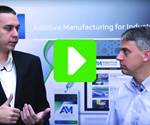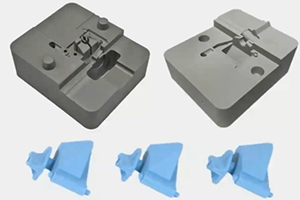Listen: Podcast Discusses Trends, Benefits of Metal AM for Moldmaking
An episode of the Manufacturing Alliance podcast recorded live at NPE2018 features industry experts discussing who benefits from using additive manufacturing in moldmaking and which AM trends are helping moldmakers.
NPE is all about plastics, but metal additive manufacturing (AM) had a place at the show as well. The event drew many moldmakers, some of which were showcasing metal AM capabilities used to produce plastic injection molds and die-cast dies.
Tony Demakis of Alliance Specialties and Laser Sales and Rich Oles from ROI Rich Oles Industries brought their Manufacturing Alliance podcast to NPE2018, recording live episodes at Gardner Business Media’s booth (the publisher of Additive Manufacturing). Along with industry experts William Sames of HTS International and John Tenbusch of Linear AMS, they discussed the present and future of metal additive manufacturing for moldmaking.
According to the guests, metal AM is already widely applicable for producing molds and dies. “We’ve had a number of our customers say, ‘We could utilize this in 15 percent of the tools we make,’ and many of those guys make 500 or 600 tools per year,” Tenbusch says. As the technology advances further, they expect the use of metal additive manufacturing for moldmaking to grow. Developments like bigger build plates, more process control and less need for support structures have the potential to increase its use. This will also help the technology continue its transition to proactive from reactive. Tenbusch says that more of his customers are turning to AM to make improvements instead of address problems.
One important point the guests made is that moldmakers themselves are often not the ones who experience the benefits of using additive manufacturing. AM doesn’t enable them to produce molds cheaper or faster—but it gives them the ability to create features like conformal cooling channels that cannot be produced with traditional machining methods. These features help users get the most out of a mold by reducing warp in the molded part, improving cycle time and extending the life of a mold. Sames describes it as “putting a Cadillac engine into a mold to make it go faster.” He estimates that 90 percent of the profits from conformal cooling productivity gains go to the users of the mold, not the moldmakers.
The hosts and guests also discussed trends in metal additive manufacturing for mold and die making, including:
- Software analysis. Both guests use plastic injection molding simulation software to study the feasibility of molds before producing them. Sames’ company has an R&D partnership with Sigmasoft, which they use to compare actual molds to software simulations. He says that the software simulations have been very accurate. Tenbusch uses Moldex3D, which he says has improved to include features that automate the process and make it easier for him to accommodate more customers.
Sames also says that HTS starts its process by using a simple Solidworks finite element analysis to quickly compare cooling arrangements in two inserts side by side. This analysis doesn’t give any information on cycle time, flow or warpage, but he says it helps simplify the decision-making process for companies that are just starting to use conformal cooling. “We can run one of these in five minutes instead of starting with a transient simulation and then iterating there,” he says. - Repair and refurbishment. Having the ability to repair or refurbish molds with AM is a big advantage, because it can save users time and money compared to traditional repair methods or making a new mold entirely. Tenbusch shared an example of how Linear was able to repair a mold by cutting off the damaged part and re-growing it with additive manufacturing. The process took only five days. Sames says that HTS has also been able to repair molds for its customers in the packaging industry by removing fragile copper caps that have been soldered onto old inserts and building steel onto the insert instead.
- Standardization. Both Sames and Tenbusch mostly deal in one-off custom parts, so it’s important to standardize where possible. Sames says that his company is working on standardizing sizes of sprue bushings and gate inserts in the molds it makes. “What we’re trying to do is roll that out in standard sizes and eventually get that to an off-the-shelf component that can bring the costs down and bring the lead time down,” he says.
- Materials. Developing new materials is a trend in additive manufacturing at large, but for moldmaking, performing R&D on new materials is costly. Both companies have chosen to focus on a small number of materials that are known to work well for their applications. Linear AMS is currently only working with one material— “We’ll print any material you want as long as it’s MS1,” Tenbusch jokes. He adds that he feels that Linear’s customers have validated the material and proved its effectiveness.
One advancement Tenbusch says he is particularly interested in is the possibility of changing the parameters (power, wattage, speed, number of passes) on AM machines to make a single powder take on the properties of different materials.
Related Content
The Connector Conundrum: 3D Printed Mold Tooling’s Role in Innovation
ReelView Fishing faced an electronics obstacle in the development of its new technology for underwater video. Additive manufacturing for moldmaking allowed for the speed necessary to iterate to a solution. How inventors and invention will benefit from new ways of obtaining production-ready tooling.
Read MoreCombining Metal and Polymer for Better 3D Printed Tools
Applications prone to wear call for more durable tooling than 3D printed polymer alone, but full metal is not always necessary.
Read More3D Printed Mold Tooling Advances in Performance With Proprietary Resin
Material improvements offer turnkey production and cost trimming with 3D printed mold tooling. A new, proprietary resin addresses the current limitations associated with 3D printing in polymer.
Read MoreNicolet Plastics Succeeds Using Mantle's Hybrid Metal 3D Printing Method for Mold Tooling
A recent webinar explores Nicolet Plastics’ success using Trueshape Technology, Mantle’s approach to print injection mold tooling. The current challenges this technology addresses and alleviates in additive manufacturing confirms this method is effectively reducing lead times and cost constraints, while producing better inserts.
Read MoreRead Next
Video: The Case for Hybrid Manufacturing in Moldmaking
Instead of relying on EDM to machine features recessed deep into the part, machine those features while 3D printing progresses, finishing them before they become hard to reach.
Read MoreBike Manufacturer Uses Additive Manufacturing to Create Lighter, More Complex, Customized Parts
Titanium bike frame manufacturer Hanglun Technology mixes precision casting with 3D printing to create bikes that offer increased speed and reduced turbulence during long-distance rides, offering a smoother, faster and more efficient cycling experience.
Read MorePostprocessing Steps and Costs for Metal 3D Printing
When your metal part is done 3D printing, you just pull it out of the machine and start using it, right? Not exactly.
Read More





















